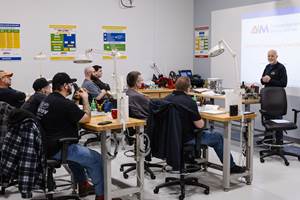Business Growth Through Employee Ed and Shop-Floor Training
As we begin to rebound from one of the most brutal economic downturns in modern history, you may be realizing the importance of diversification.
Share
As we begin to rebound from one of the most brutal economic downturns in modern history, you may be realizing the importance of diversification. As you begin to diversify, you are probably becoming aware of very real opportunities to grow your business. In an effort to capitalize on these opportunities, you may be investing in new machines or software, or even a new certification of some kind. All of these investments may be necessary to properly update your shop to at least get on the same level as the competition, but are they going to be enough to get your company to stand out in a new market?
All of your competitors have access to the same machines, software and certificates that you do. So do these investments really give you the competitive edge? No, they do not. Do not get me wrong, technology is vitally important, but what gives your company the real competitive edge is not as much what tools or technology you purchase, but how you use the tools and technology that you purchase. This is called innovation.
Innovation is essential to growth. In our highly competitive industry, you need every employee to look for ways to improve. Everyone in your shop must generate new ideas, and find new ways to use the investments you have made in technology. To do this, your employees must be adequately trained and educated. Training and education are two different things. Training refers to the skills needed to do a job—how to set the z-height of a cutter on a particular machine for example. Whereas, education refers to the general knowledge base of a particular topic. For example, what are cutter coatings and what do they do in the cut zone.
A properly trained and educated employee—placed in a work culture focused on continuous improvement—will generate innovation. Every employee in your shop has the potential to give you the edge over your competition if they understand the technology they are working with. And not just how it works, but why it works as well. When one of your shop floor workers begins to see the big picture behind how the technology has been designed, they will start to find new and unpredictable ways to shorten leadtimes, reduce rework, and increase efficiency and profitability.
How do you begin to find out if your employees have the training and education they need to drive innovation in your shop? The first step is to identify what you think they should know and what you think they should be able to do. If you have the time, you can start by making a list of requisite knowledge and skills for each job description. You also can work with a consultant or educational institution that has experience defining job knowledge and skill requirements. Once your lists are made, you must determine the appropriate assessments needed to identify the knowledge and skill gaps. These can be verbal or written assessments, or assessments requiring the demonstration of a skill.
Once you have the knowledge and skill gaps identified and measured, you can decide the appropriate means of filling them. Perhaps you can use a class at the local community college or you can bring in a technology representative, or maybe have your employees take an online course. There are many ways to get your employees properly trained and educated, but the key is to approach it systematically—leaving nothing to assumption or chance.
Taking the time to properly train and educate your shop floor employees will drive innovation at your company. Innovation is the only authentic competitive edge you have, and it is essential to success when pursuing a new business opportunity.
Related Content
Making Quick and Easy Kaizen Work for Your Shop
Within each person is unlimited creative potential to improve shop operations.
Read MorePredictive Manufacturing Moves Mold Builder into Advanced Medical Component Manufacturing
From a hot rod hobby, medical molds and shop performance to technology extremes, key relationships and a growth strategy, it’s obvious details matter at Eden Tool.
Read MoreThe Role of Social Media in Manufacturing
Charles Daniels CFO of Wepco Plastics shares insights on the role of social media in manufacturing, how to improve the “business” side of a small mold shop and continually developing culture.
Read MoreMold Maintenance Continues to Matter: Enhanced Training Program in a New Facility
I attended a MoldTrax mold maintenance workshop in 2019 and shared my experiences, and despite changes in ownership, the workshop's remarkable value endures, as discussed in a recent Q&A with the current leadership.
Read MoreRead Next
How to Use Continuing Education to Remain Competitive in Moldmaking
Continued training helps moldmakers make tooling decisions and properly use the latest cutting tool to efficiently machine high-quality molds.
Read MoreAre You a Moldmaker Considering 3D Printing? Consider the 3D Printing Workshop at NPE2024
Presentations will cover 3D printing for mold tooling, material innovation, product development, bridge production and full-scale, high-volume additive manufacturing.
Read MoreHow to Use Strategic Planning Tools, Data to Manage the Human Side of Business
Q&A with Marion Wells, MMT EAB member and founder of Human Asset Management.
Read More























